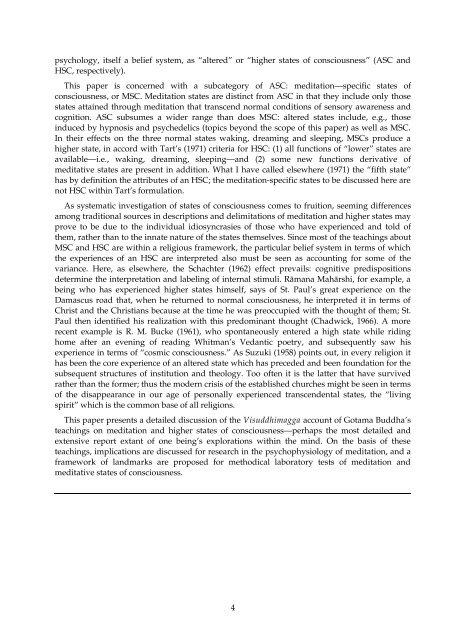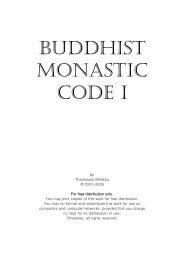THE BUDDHA W MEDITATION - Theravada Buddhism
THE BUDDHA W MEDITATION - Theravada Buddhism
THE BUDDHA W MEDITATION - Theravada Buddhism
You also want an ePaper? Increase the reach of your titles
YUMPU automatically turns print PDFs into web optimized ePapers that Google loves.
psychology, itself a belief system, as “altered” or “higher states of consciousness” (ASC and<br />
HSC, respectively).<br />
This paper is concerned with a subcategory of ASC: meditation—specific states of<br />
consciousness, or MSC. Meditation states are distinct from ASC in that they include only those<br />
states attained through meditation that transcend normal conditions of sensory awareness and<br />
cognition. ASC subsumes a wider range than does MSC: altered states include, e.g., those<br />
induced by hypnosis and psychedelics (topics beyond the scope of this paper) as well as MSC.<br />
In their effects on the three normal states waking, dreaming and sleeping, MSCs produce a<br />
higher state, in accord with Tart’s (1971) criteria for HSC: (1) all functions of “lower” states are<br />
available—i.e., waking, dreaming, sleeping—and (2) some new functions derivative of<br />
meditative states are present in addition. What I have called elsewhere (1971) the “fifth state”<br />
has by definition the attributes of an HSC; the meditation-specific states to be discussed here are<br />
not HSC within Tart’s formulation.<br />
As systematic investigation of states of consciousness comes to fruition, seeming differences<br />
among traditional sources in descriptions and delimitations of meditation and higher states may<br />
prove to be due to the individual idiosyncrasies of those who have experienced and told of<br />
them, rather than to the innate nature of the states themselves. Since most of the teachings about<br />
MSC and HSC are within a religious framework, the particular belief system in terms of which<br />
the experiences of an HSC are interpreted also must be seen as accounting for some of the<br />
variance. Here, as elsewhere, the Schachter (1962) effect prevails: cognitive predispositions<br />
determine the interpretation and labeling of internal stimuli. Rāmana Mahārshi, for example, a<br />
being who has experienced higher states himself, says of St. Paul’s great experience on the<br />
Damascus road that, when he returned to normal consciousness, he interpreted it in terms of<br />
Christ and the Christians because at the time he was preoccupied with the thought of them; St.<br />
Paul then identified his realization with this predominant thought (Chadwick, 1966). A more<br />
recent example is R. M. Bucke (1961), who spontaneously entered a high state while riding<br />
home after an evening of reading Whitman’s Vedantic poetry, and subsequently saw his<br />
experience in terms of “cosmic consciousness.” As Suzuki (1958) points out, in every religion it<br />
has been the core experience of an altered state which has preceded and been foundation for the<br />
subsequent structures of institution and theology. Too often it is the latter that have survived<br />
rather than the former; thus the modern crisis of the established churches might be seen in terms<br />
of the disappearance in our age of personally experienced transcendental states, the “living<br />
spirit” which is the common base of all religions.<br />
This paper presents a detailed discussion of the Visuddhimagga account of Gotama Buddha’s<br />
teachings on meditation and higher states of consciousness—perhaps the most detailed and<br />
extensive report extant of one being’s explorations within the mind. On the basis of these<br />
teachings, implications are discussed for research in the psychophysiology of meditation, and a<br />
framework of landmarks are proposed for methodical laboratory tests of meditation and<br />
meditative states of consciousness.<br />
4






